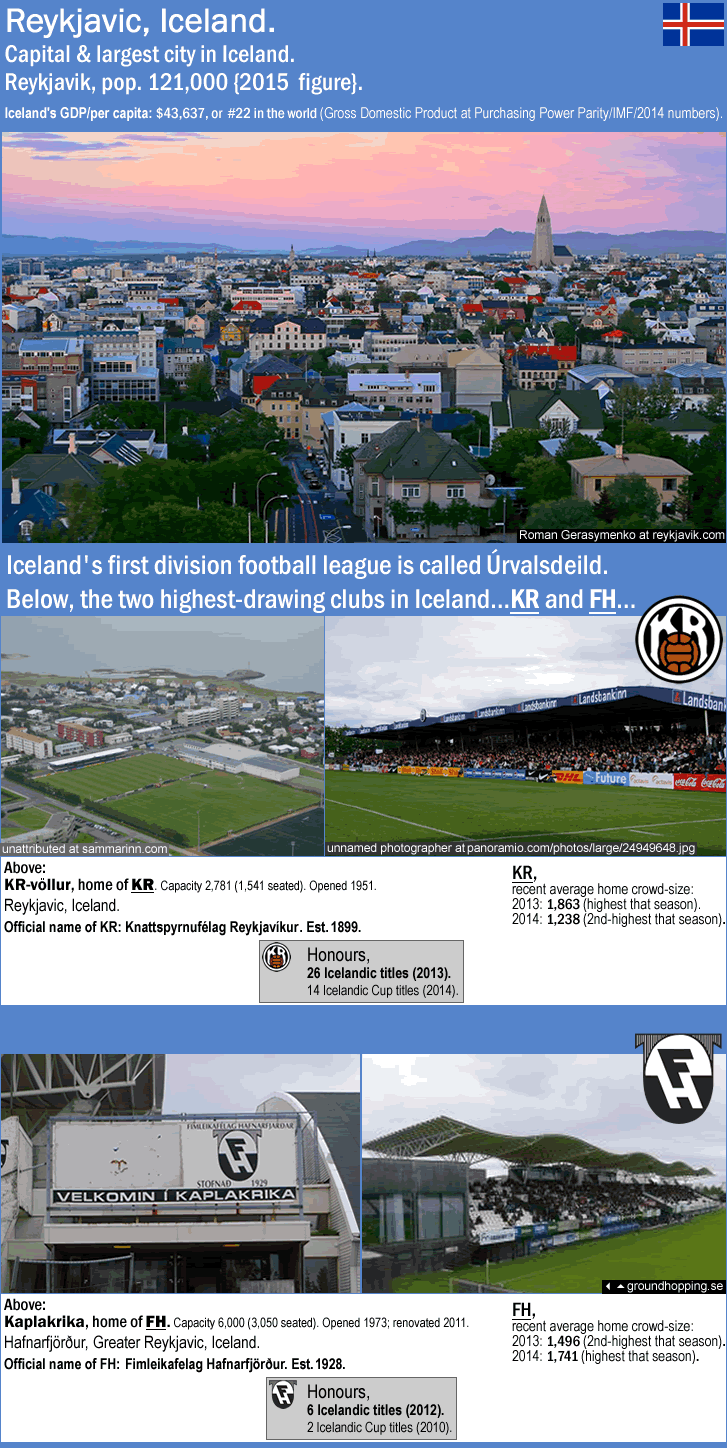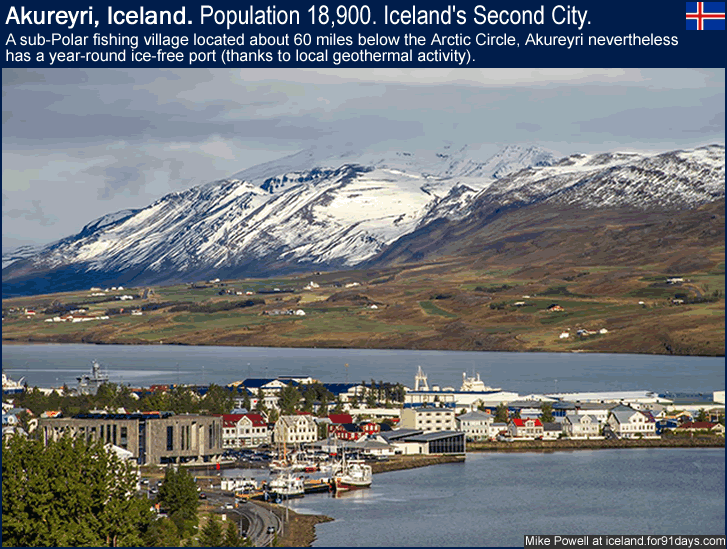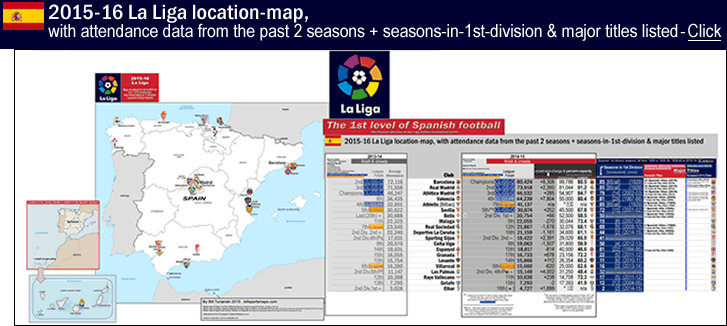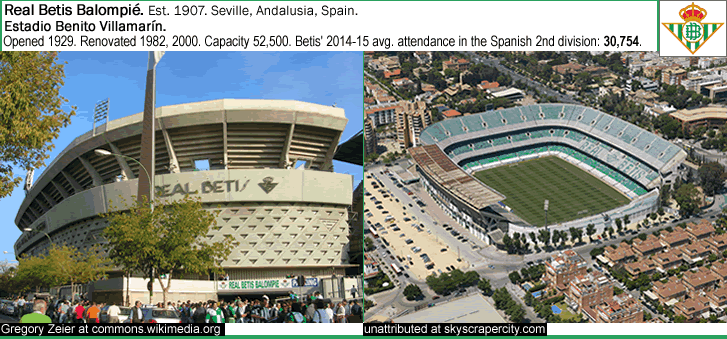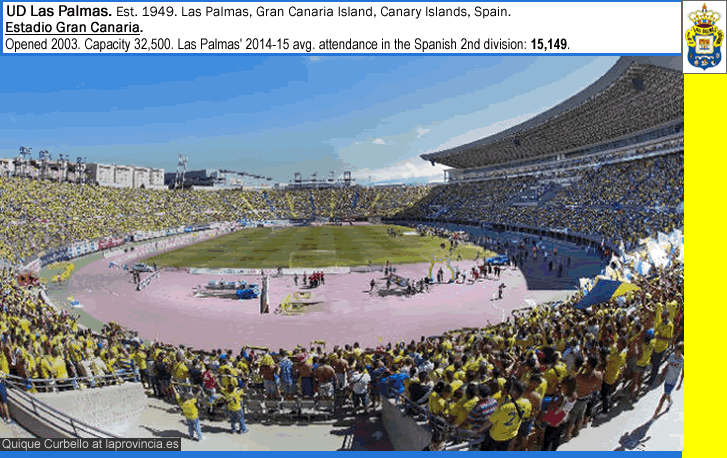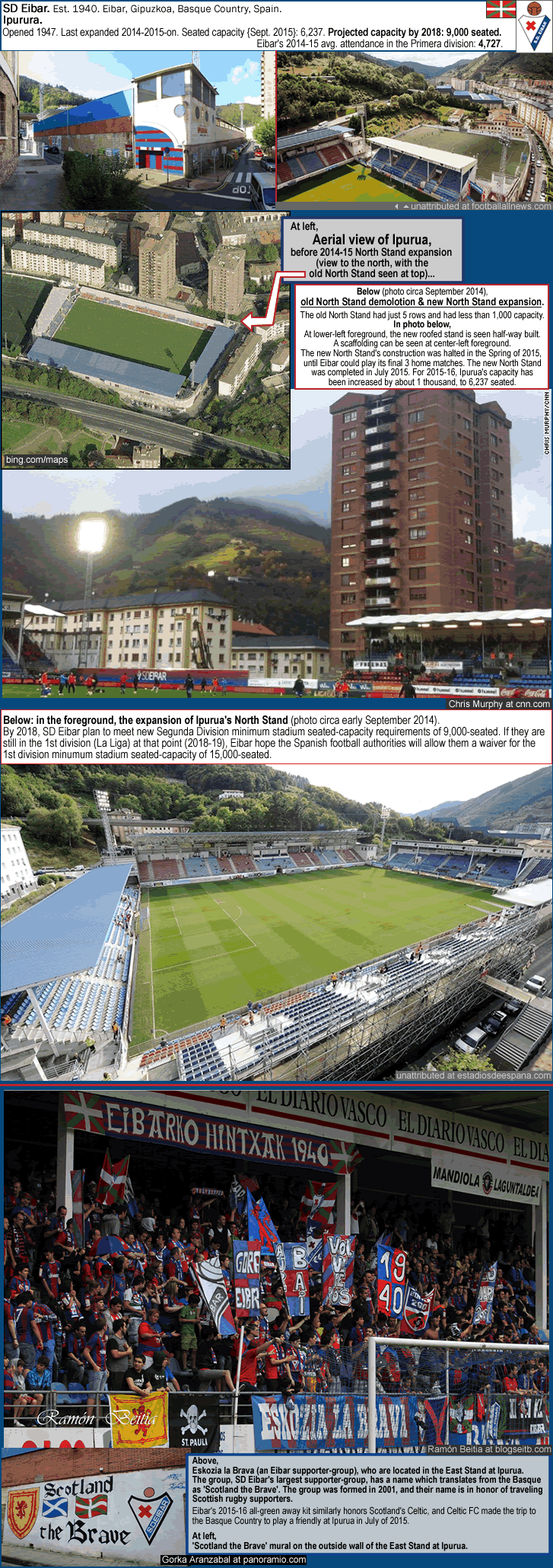(Note: to see my latest map-and-post on Italian football, click on the following, category: Italy.)
.
.
.
.
.
.
.
.
.
.
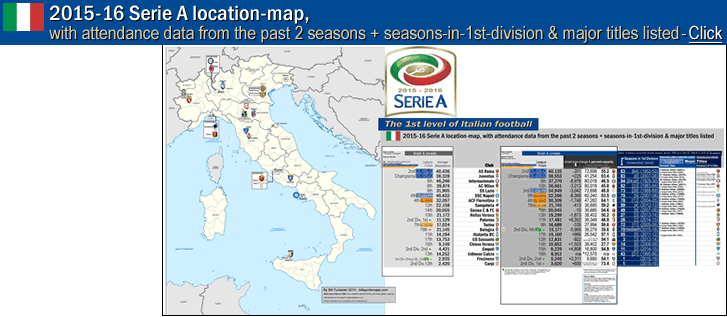
Italy: 2015-16 Serie A location-map, with: 14/15 attendance data, seasons-in-1st-division-by-club & major titles listed
…
…
Links…
-Teams, etc…2015–16 Serie A (en.wikipedia.org).
-English-speaking coverage of Italian football…Forza Italian football.com.
-Here is the archive-page of Serie A-focused Guardian.com/football writer Paolo Bandini, {archive page, Paolo Bandini (theguardian.com/profile/paolobandini).}
-Table, fixtures, results, stats, etc…Serie A/summary (soccerway.com).
…
By Bill Turianski on 28 September 2015; twitter.com/billsportsmaps.
-
Italy: 2015-16 Serie A location-map, with: 14/15 attendance data, seasons-in-1st-division-by-club & major titles listed
Template…
I am using the same template I have used with my recent maps of the 2015-16 1st divisions of England, Germany, and Spain. I still have France to do, and I plan on posting Ligue Un 2015-16 map-and-post on Saturday 10 October. Anyway, listed at the chart at the right-hand-side of the map page are the following 6 things…Average home attendance (league matches) the past 2 seasons, including 14/15 Percent-Capacity and Crowd-size change. League finish the last 2 seasons. Seasons-in-1st-division (and consecutive seasons noted). Italian titles (with last title listed). Coppa Italia titles (with last title listed). Major international titles (with last titles listed) [Anglo-Italian Cup? Sorry, never a major title.]
Features on map…
The map includes the listing of the 20 Regions of Italy (which is the first political division in Italy). The map also features the 6 largest cities in Italy (in order of largest-to-smaller, here are the most-current city population figures [as opposed to the (much-larger) metro-area-population-figures]…Rome/2.8 million, Milan/1.3 million, Naples/.98 million, Turin/.89 million, Palermo/.67 million, Genoa/.52 million). {Source: 2014 & 2015 figures at List of largest cities in the European Union by population within city limits (en.wikipedia.org).}
4 stadium-shares in the 2015-16 Serie A…
There are 4 stadium-shares in the 2015-16 Serie A (in Genoa, Milan, Rome, and Verona), and they are all noted on the map. The map also shows the two clubs in Emilia-Romagna who have been forced by the Italian football authorities to play in larger nearby stadiums. Those 2 clubs are third-year-top-flight club Sassuolo; and the white-and-red-clad Carpi, who are making their top flight debut in 2015-16. Both had been originally playing in very tiny 4-K-capacity stadiums.
Below, venue-locations and home-locations of Bologna, Sassuolo & Carpi…
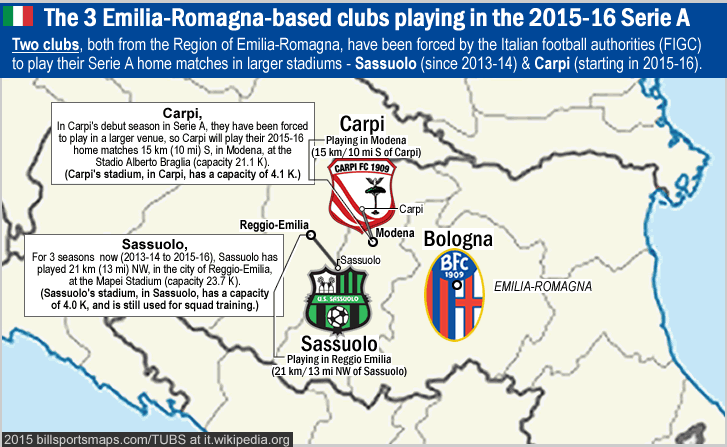
Image credit above – segment of Blank map of Italy by TUBS, at File:Italy provincial location map.svg.
For Sassuolo, playing about 15 miles (21 km) away, in the city of Reggio-Emilia, has worked out OK for the turtle-green-&-black-striped side. Sassuolo are not drawing bad at all for a club that pretty much sprang up out of nowhere three-or-four years ago. Sassuolo have been drawing between 12 to 13 K the past 2 seasons, and actually seem to be establishing themselves as a viable top tier club, with a 12th-place finish last season. And Sassuolo have started strong in 15/16, in 4th place after 6 matches.
…
Carpi are not playing in their stadium because it is pretty inadequate…
But it really remains to be seen if the back-to-back-promoted Carpi can weather such a venue-shift as well. Because there are other factors with respect to Carpi…namely, that many supporters did not want their Cinderella-club’s historic first-division debut season to be played down the road, at the five-times-larger stadium of hated local rivals, Modena. One of the larger supporter-groups of Carpi – a group named Guidati dal Lambrusco – have actually announced they will boycott home matches. {For more on that, see the following article. Here is Gentleman Ultra’s excellent August 2015 post, at Guardian.com/football, on Carpi’s Serie A debut season, Carpi: Serie A alternative club guide (by Richard Hall and Luca Hodges-Ramon at theguardian.com/football)}.}.
Below – Stadio Sandro Cabassi, home of Carpi FC when they play in the lower divisions; and Carpi’s home-venue for Serie A, Stadio Alberto Braglia in Modena…
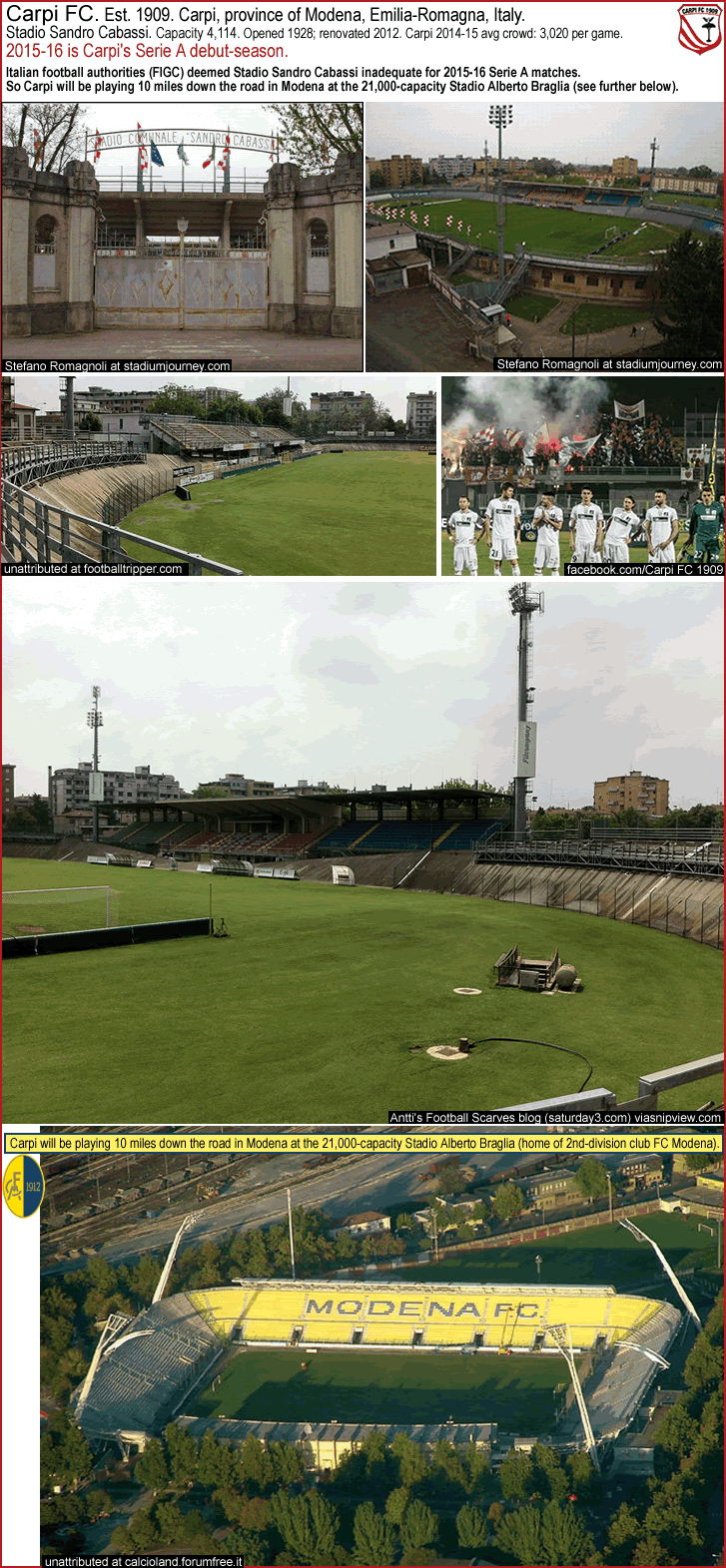
Photo and Image credits above – Entrance to stadium, photo by Stefano Romagnoli at stadiumjourney.com. Rooftop-view of stadium, photo by Stefano Romagnoli at stadiumjourney.com. Interior photo of “stadium”, photo unattributed at footballtrip.com. Shot of Carpi squad with fans in background, photo from facebook.com/Carpi FC 1909. Larger photo of venue, photo by Antti’s Football Scarves blog (saturday3.com) via snipview.com. Modena stadium, photo unattributed at calcioland.forumfree.it [Serie B stadiums thread].
So one of the largest Carpi supporter-groups is boycotting their own home games. This does not bode well for Carpi. Their stadium, as you can see further above, is the 4.1-capacity Stadio Sandro Cabassi. Look at the rust on the gates of the main entrance, and look at the black mold-scum festering at the tops of the granite walls. You call that inviting? I call it scary. Look at those tiny isolated-and-fenced-off bleacher-stands there behind the goals, then look at the slanted concrete moat (is this police-state-type concrete moat/riot-wall actually necessary?), and then look at the barbed-wire-topped riot-fence ringing the pitch. What is this, a convict-holding-pen or a football stadium? That faction who is boycotting Carpi’s home matches because they now have to play home matches at the hated Modena, well, they should not be casting stones at someone else’s house, so to speak. Because their club’s home ground is pretty dire. And besides, Carpi is averaging 10.6 K right now, whereas they could only average 4.1 K in their own stadium (see this/from 22 Sept. 2015). Hey boycotting Carpi fans, where do you think the extra 6 K each game of ticket-revenue goes to, which your club is now getting (at Modena)? It goes straight to your club, you boycotters. This is not rocket science. Carpi is literally profiting from their move to Modena. But meanwhile, a fan-group of Carpi boycotts their home matches – out of misplaced spite. Where is the logic in that? Hey fan-group…your boycott might mean ‘we hate Modena’ to you, but it also NOW means ‘we don’t want our club to earn more ticket-revenue’. Well, those boycotters will probably be able to watch Carpi at their home ground in 2016-17. Because it is starting to look like Carpi are going straight back down to Serie B. Carpi sit last on 2 points after 6 matches. And they sacked their manager on Sunday 28 September after the 6th game – a 5-1 shellacking by Roma.
…
Frosinone – also with a Serie A debut in 2015-16, and their ground, Stadio Matusa…
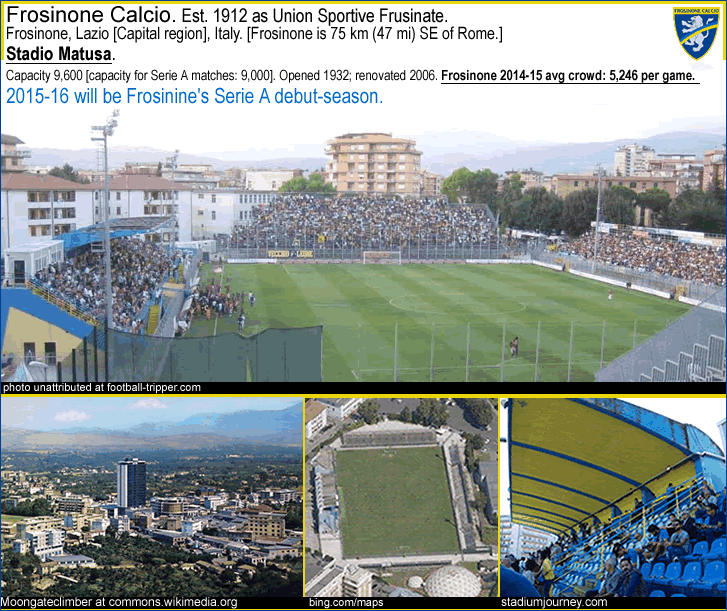
Photo and Image credits above – aerial shot of stadium, photo unattributed at football-trip.com. File:Panorama Frosinone edit.jpg, photo by Moongateclimber at commons.wikimedia.org.
Roofed main stand, photos from stadiumjourney.com/stadiums/stadio-comunale [Frosinone]. Aerial image of stadium , screenshot of bird’s-eye satellite view at bing.com/maps.
Frosinone are from the city of Frosinone, which is located 75 km (47 mi) SE of Rome. Frosinone is connected to the capital by the A1 motorway (both are in the region of Lazio). The town serves somewhat as a bedroom community for commuters who work in Rome. The city of Frosinone has a population of around 46,000 {2014 estimate}. Frosinone Calcio wear all-yellow with royal blue trim. Frosinone Calcio, like Carpi FC 1909, are making their first division debut in 2015-16. Also like Carpi, Frosinone have a small ground. But Frosinone is a club that is about twice as big as Carpi as measured by gates – Carpi drew 3.0 K last year, while Frosinone drew 5.2 K. And Frosinone’s ground is not nearly as small or decrepit as Carpi’s ground. And Frosinone’s ground – the 9.6-K-capacity Stadio Matusa – passed muster by FIGC, and the club will be hosting their 2015-16 Serie A home matches there.
Frosinone’s stadium looks pretty nice (no running track!), and the worst I can see is a bit of rust at the welding joints on their nicely archaic cantilever roof (see it above), which covers part of the main stand on the west side of the stadium (there is minimal roof-coverage at the ground, because there is not much rain there in that part of south-central Italy).
The then-struggling Frosinone got their first point in Serie A in the 5th round on 23 Sept. 2015, with a 1-1 result against reigning champions Juventus in Turin. It was a last-minute 94th-minute goal (the goal was a dramatic header from a corner-kick, by actual Juve-supporter Leonardo Blanchard). Juventus might also be really struggling, but what a way for Frosinone to record their first point in the top flight. From reddit.com/r/soccer, thread: reddit.com/r/soccer/comments/blanchard_last_minute_goal_vs_juventus [23 Sept. 2015]/. From Guardian/football, Frosinone’s Leonardo Blanchard savours historic goal against Juventus (by Paolo Bandini on 24 Sept. 2015 at theguardian.com/football).
Then Frosinone beat fellow minnows Empoli 2-0 on Monday the 28th of September, to move out of the relegation zone. Go Frosinone! It is starting to look like a decent start for Frosinone, but, like Carpi, it will be an uphill battle for Frosinone to stay up.
…
Bologna are back in the top flight after winning the 2014-15 Serie B play-offs…
Bologna are one of the nine or ten biggest yo-yo clubs in Europe (“up there” with Hertha Berlin, FC Köln, FC Nürnberg, Sunderland, FC Kaiserslautern, RC Lens, Norwich City, Wolverhampton, and Sporting Gijón). Bologna has suffered two relegations in the last 10 years (in 2005-06 and in 2013-14), and otherwise have been perennial lower-table/relegation-battlers in the top tier (with 17th-place finishes in 2008-09 and in 2009-10, a 16th-place finish in 2010-11, and a 13th-place finish in 2012-13, one year before getting the drop in 2013-14 as 19th-place finisher). And wouldn’t you know it? After 6 games into the 2015-16 Serie A, Bologna is right back in a relegation-battle already, with 1 win and 5 losses, and sitting second-from-bottom in the table.
The Italian 2nd division play-off system – complicated but fair…
Last season, Bologna won the complicated-but-equitable Serie B play-offs. I say equitable because the Italian football authorities have sensibly figured out a way to have a play-off system which rewards final league placement…by giving the higher-placed club the tiebreaker in aggregate score. And 4th-place Bologna utilized that rule to beat Avellino 3-3 aggregate and then in the 2014-15 Serie B play-offs finals, Bologna beat Pescara 1-1 aggregate. Both times Bologna got the nod with a better 4th place finish than 8th-place Avellino and 7th-place Pescara. Hey England, this play-offs aggregate tiebreaker rule is a brilliant idea, which needs to be adopted in the Football League. Hats off to the Italian football authorities (FIGC) for the progressive tweak in the lower-divisions play-offs rules…a rule that benefits those promotion-candidates who finish higher. Which is only fair.
Bologna’s stadium has a stupid running track…
Bologna play at the 32-K-capacity Stadio Renato Dall’Ara, which (sigh) has a stupid running track. Oh Italy, when will you learn? Your stupid running-track-infested municipal stadiums are ruining your game. Get the memo, Italy. ALL football fans detest stadiums with running tracks. Italy, please, I beg of you. Build some new 1st-divison-worthy football stadiums without running tracks, already. If Bordeaux, France can do it, than I am pretty sure Bologna, Italy could too.
Why are there running tracks in most 1st division municipal stadiums in Brazil or Italy or other quasi-Third-World nations?
Seriously…WHY? Is it stupid urban planners there, or is it the fear of goons running onto the field there? Either way, it is ruining their product.
I mean come on, Italy. It’s embarrassing. Serie A regularly features some of the highest-calibre and watchable pro football anywhere on the planet…but it is so often being played in dumps of stadiums with (or formerly-with) those stupid running tracks. Stadiums that should have seen the wrecking ball years ago. All over the Italian peninsula. Currently 35% of all 2015-16 Serie A matches are being played in lame-ass venues afflicted with the accursed running tracks. Such as in Rome (2 teams). And such as in Naples. And such as in Verona (2 teams). And such as in Empoli. And such as in Bologna (see photo in illustration below). And the filled-in running-track stadiums in Serie A are pretty lame too (Palermo, Fiorentina, Torino, Atalanta [Bergamo]). At least, besides Juventus’ recently-new stadium (Juventus Stadium, opened Sept. 2011), there is one other recent ray-of-hope on the stadia front in Italy – and that of course is the massive re-build going on the past 2-and-a-half years up in far north-east Italy at Stadio Friuli, in Udine, home of Udinese Calcio…from Stadium DB site, from 13 Sept. 2015, update on the re-build at: Stadio Friuli (stadiumdb.com).
Bologna FC, and their home, Stadio Renato Dall’Ara…
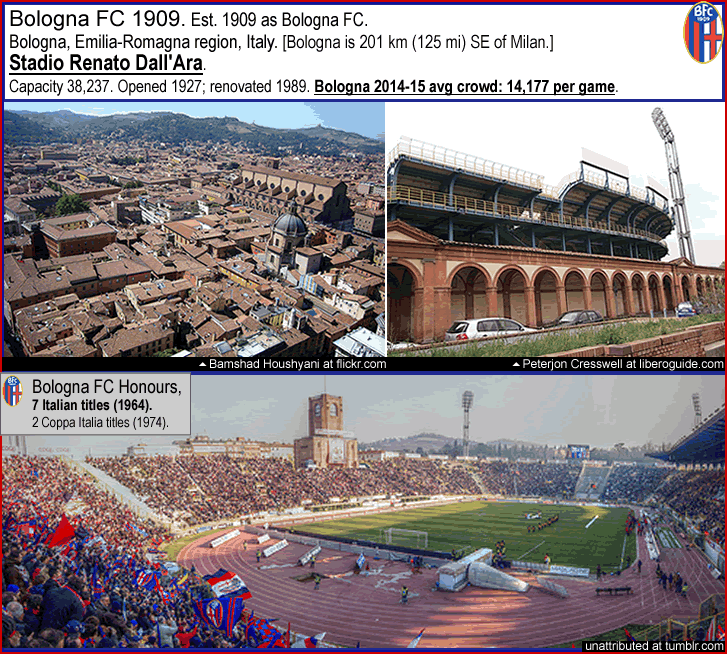
Photo credits above – Aerial view of Bologna, photo by Bamshad Houshyani at flickr.com via happytellus.com. View of stadium from curva, photo unattributed at tumblr.com/search/stadio (scroll down at the bottom of that post for plenty of photos of the renovation at Stadio Friuli).
___
Thanks to all at the links below…
-Blank map of Italy by TUBS, at File:Italy provincial location map.svg.
-Attendances from E-F-S site, european-football-statistics.co.uk/attn.htm.
-2014-15 stadium capacities (for league matches) from 2014–15 Serie A (en.wikipedia.org); Serie A (it.wikipedia.org).
